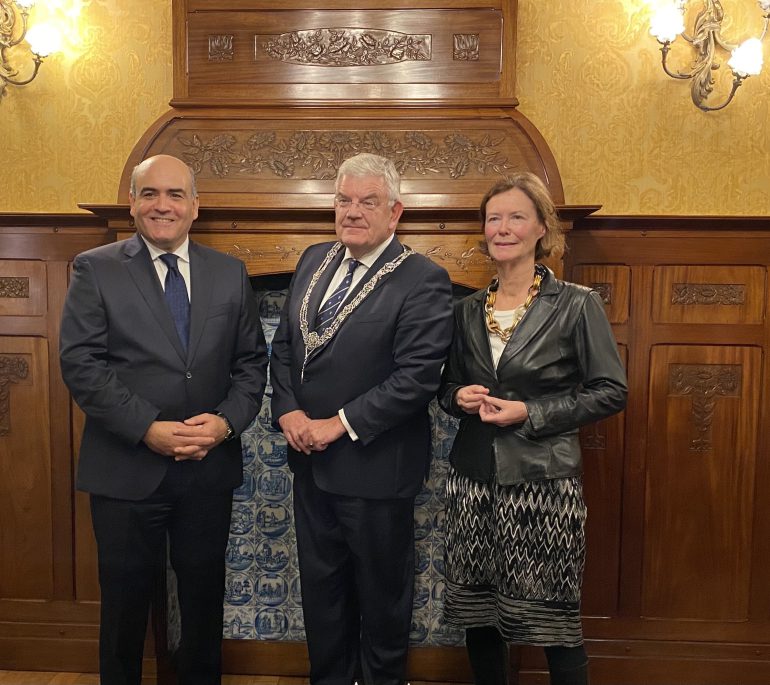On Thursday 12 January a reception was hosted by the Ambassador of the Arab Republic of Egypt, H.E. Mr. Hatem Elsayed Kamaleldin to mark the newly renovated monumental Egyptian Residence at Surinamestraat 22 in the Hague. This house was built by the parents of the great Dutch writer, Louis Couperus who lived in this house.
The guests were welcomed by the Egyptian Ambassador and in his welcome words he mentioned that, a few days after his arrival to The Hague, he received an assignment to begin the restoration and renovation process of the residence and that the process took almost one year. Moreover, he was proud that the building status returned to its original state as it was since the Government of Egypt bought in it 1927. The Ambassador affirmed the monumental value to the Netherlands as it was built in the 19th century and it was owned by the prestigious Dutch writer Louis Couperus.
The next speech was given by the Mayor of The Hague, Mr. Jan van Zanen. The mayor mentioned that the re-opening of the Egyptian residence is an important moment. After all, the building is one of great cultural and historical value. The heritage represented by this house goes well beyond The Hague. It was here that Couperus wrote the first part of “Eline Vere” in 1888. The novel first appeared as a serial in the newspaper and in the form of a book. Eline Vere is not only renowned as being among the best of Dutch literature but Couperus also gives a glimpse of life in The Hague in the late 19th and early 20th century, as in his other books. And if there is one place in The Hague that could be described as the backdrop for his novels, his own life and The Hague of his times, it is the Surinamestraat.
Couperus travelled to various European countries, as well as Japan and today’s Indonesia, for example where he lived as a child. A country which he did not visit but which he certainly celebrated in literary for, is Egypt. In his novel “Antiek toerisme” (the tour: a story of Ancient Egypt) he had a wealthy Roman visit Egypt in the first century of our era. That this building, so closely associated with Couperus houses the Egyptian residence, could thus also be said to be symbolic. It is all the more fitting that this house has now been restored to its former glory. We are indebted to the Egyptian government and Ambassador Kamaleldin in particular. The mayor ended his speech with the following words: May this restoration be an example for other embassy buildings in The Hague that are also in need of restoration.
The last speech was given by the Director of the Couperus Museum, Mrs. Josephine van Mortel. She mentioned that Couperus’s father called the house “Suriname Hotel” where the family was always welcome. The house was sold a year after Couperus’ father passed away to the family van Deventer who sold the property to the Government of Egypt in 1927.
‘Eline Vere’ is Couperus’ first and most famous book. It was so popular that people in the tram would whisper to each other: ‘Have you heard it yet? Eline is dead.’ In ‘The Small Souls’ Couperus describes the Surinamestraat as follows: The two rows of façades ran along with a fine independency of chimney-stacks, zinc roofs, little copper westhercocks and balconies, as though the builders had conspired to produce something artistic. Couperus is still very much alive. This year we commemorate the fact that Couperus died 100 years ago. In the Louis Couperus Museum just around the corner you can visit the intriguing exhibition ‘Louis Couperus non-binary avant la lettre’. The exhibition is about the person behind the writer and the characters in his books. Mrs. van Mortel ended her speech with the words: to-night is a real party in Couperus’ style. He would have loved this. Let us raise the glass to drink on Couperus, Egypt, The Hague and the beautiful Surinamestraat.
Afterwards we were treated with drinks and Egyptian delicacies, which was much appreciated by the guests. There was a great ambiance.
Written by Nanda Jagusiak-Monteiro
